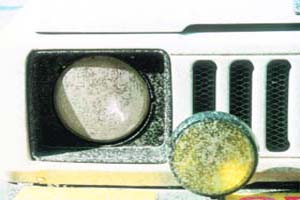|
Good Motoring
Drive slow on wet
roads
H. Kishie Singh 
THE monsoons have
arrived. This means we will be driving on the wettest roads in
the world. Adding to the water will be mud, slush and, maybe,
even snow in the upper reaches of the Himalayas. It is time to
offer a prayer to the "tyre devta," who will be
your only contact with Mother Earth. A good set of tyres is
essential. It will provide traction, good braking and cornering.
All of which are important to keep your car on the road in a
safe and secure condition.
After a long dayís
drive, when the wipers have been hard at work, the windscreen
can be almost opaque, except for the area swept by the wiper
blades. Visibility is almost nil through the unswept area. The
area is coated with mud and slush. This is true of your
headlights also. The lens can have a coating of mud, and you can
have a loss of illumination of up to 70 per cent. The
accompanying photograph shows how a coating of mud can render
the headlights ineffective.
|

Keep the headlights of your vehicle clean. These need to be switched on even during the day as visibility is low in the rainy season
|
Unless you have a
headlight washer provided by the manufacturers, you have no
option but to manually wash the headlights just before sun down.
On wet roads, with rain and low visibility, strong headlights
are a must. As you wash your headlights, remember to top up the
windshield water bottle. It is essential in keeping the
windshield clean. While driving long distances on wet roads,
especially through puddles, pump your brakes to dry them out.
Brake failure due to wet conditions is a constant threat to
drivers. See and be seen.
Keep the
headlights of your vehicle on even during the day to make sure
others see you. These should be on low beam so that you donít
blind the on-coming drivers. Reducing speed increases your
safety immensely. On a wet road, braking distances increase. A
lower speed will help you stop in time. Keep well behind the
vehicle in front. Also, keep in mind that road conditions will
change every few kilometres. They cannot stay constant.
Compensate for these ever changing road conditions.
You, the driver,
are sitting in a warm or A/C cabin, comfortable and protected
from the elements. The pedestrian, cyclist, rickshaw-puller,
maybe a dog or two, are looking out for themselves ó eyes half
closed, shielding themselves against the rain. They may not see
you. It is your duty to look out for them and give them
priority.
There is one
aspect of driving that catches even the most experienced drivers
unawares. A skid. It happens suddenly and without a warning. On
a wet road, chances of a skid increase many times. How does it
happen? A skid almost invariably starts in the front wheels.
Throwing the steering wheel left or right will destabilise the
car. A skid happens when some slippery substances like snow,
ice, mud, leaves or oil come under the tyres. This breaks the
tyres contact with the road.
What to do? If
your car skids and faces left, steer left into the direction of
the skid. This brings all four wheels into line. Do not brake.
This will only aggravate maters. Worn- out tyres will definitely
skid. There is another danger on water-logged roads:
aquaplaning. There is an intricate pattern of cuts in your tyres.
They are designed to shed water.
When you drive on
a wet road, there is a tendency for the water to prevent
complete contact with the road. These cuts act as drains and
clear the water. In the case of aquaplaning, the water does not
drain out. This creates a thin film of water between the tyres
and the road. The steering becomes completely useless. Do not
brake. Take your foot off the accelerator.
As the car slows
down, the weight of the car will settle it down, and you will
regain control of the situation. The best remedy is to drive
slow. There can be puddles of water on the road. Drive slowly
through them. You donít know how deep they are, and a deep
puddle/pot hole can hurt your tyre and rim, and splashing water
all around is not recommended.
Finally, test your
brakes regularly. Water can reduce the effectiveness of brakes,
increasing stopping distances. It is great fun driving in the
rain, but you must exercise extreme caution.
Happy motoring
Driverís pick
Driving steady
in the monsoons is the best
and safest way to get home
|